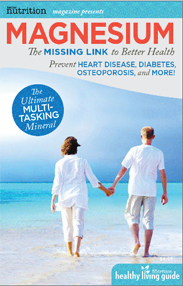Magnesium Treatment & Absorption
MAGNESIUM REQUIREMENTS – Carolyn Dean, MD, ND.
The Recommended Daily Allowance (RDA) for nutrients is set at the minimum level to stave off deficiency symptoms, not at the optimum that ensures good health. But even with the RDA set so low, most Americans are still deficient in magnesium, with men obtaining only about 80 percent of the recommended daily allowance (RDA) and women averaging only 70 percent.
The following shows the Recommended Daily Allowances (RDAs) for magnesium in children and adults.
Children 1 to 3 years: 80 mg
Children 4 to 8 years: 130 mg
Children 9 to 13 years: 240 mg
Life Stage Men Women Pregnancy Lactation
Age 14–18 410 mg 360 mg 400mg 360 mg
Age 19–30 400 mg 310 mg 350 mg 310 mg
Age 31+ 420 mg 320 mg 360 mg 320 mg
The RDA for magnesium is also expressed in mg/kg and is roughly 6 mg per kg (2.2 lb) of body weight. This standard helps to determine the magnesium requirements for someone who is overweight; a fifty-year-old who weighs 300 lbs needs more magnesium than a fifty-year-old who is 100 lbs. Many magnesium experts feel that the RDA should be increased. Twenty years of research shows that under ideal conditions approximately 300 mg of magnesium is required merely to offset the daily losses.
If you are under mild to moderate stress caused by a physical or psychological disease, physical injury, athletic exertion, or emotional upheaval, your requirements for magnesium escalate. 1,2
Dr. Mildred Seelig felt that athletic adolescent boys and girls may need 7–10 mg/kg/day and pregnancy requirements should be a minimum of 450 mg a day or up to 15 mg/kg/day.3 An average good diet may supply about 120 mg of magnesium per 1,000 calories, for an estimated daily intake of about 250 mg. 4, 5
Since at best the body is actually absorbing only half of what is taken in, researchers feel that most people would benefit from magnesium supplementation. Otherwise, body tissue must be broken down to supply vital areas of the body with essential magnesium. 6, 7
References:
1. Seelig MS, “The requirement of magnesium by the normal adult.” Am J Clin Nutr, vol. 14, pp. 342–390, 1964.
2. Seelig MS, “Magnesium requirements in human nutrition.” Magnes Bull, vol. 3 (1A), pp. 26–47, 1981.
3. Franz KB, “Magnesium intake during pregnancy.” Magnesium,vol. 6, pp. 18–27, 1987.
4. Seelig MS, “The requirement of magnesium by the normal adult.” Am J Clin Nutr, vol. 14, pp. 342–390, 1964.
5. Seelig MS, “Magnesium requirements in human nutrition.” Magnes Bull, vol. 3 (1A), pp. 26–47, 1981.
6. Glei M et al., “Magnesium content of foodstuffs and beverages and magnesium intake of adults in Germany.” Magnes Bull, vol. 17, pp. 22–28, 1995.
7. Cashman KD et al., “Optimal nutrition: calcium, magnesium, and phosphorous.” Proc Nutr Soc, vol. 58, pp. 477–487, 1999.
Magnesium Absorption
Although we do not recommend specific brands of products we can say that – “Not all forms of magnesium are equally absorbed by the body and according to research, magnesium oxide is only 4% absorbed by the body.
The amount of magnesium your tissues can readily use is based on the amount of elemental or ionic magnesium that is released. There are several organic salt chelates that are highly absorbable such as magnesium citrate, taurate and malate as are angtrom forms of magnesium. Two forms to avoid are magnesium aspartate and glutamate. Aspartate breaks down into the neurotransmitter aspartic acid, which without being bound to other amino acids is neurotoxic. Glutamate also breaks down into the neurotransmitter glutamic acid, which without being bound to other amino acids is also neurotoxic. Both are components of aspartame which should also be avoided.
1. Practitioners may have a number of reasons for suggesting a particular supplement brand.
a) Their own research of ingredients, quality and absorbability or assimilation by the body.
b) Reading research studies on a particular product.
c) Individual patient’s profile and body type.
d) Muscle testing or Kinesiology with a particular patient on a variety of supplements – choosing the best for that patient based on these tests.
e) Experience with a particular supplement and/or anecdotal results.
2. Absorbability – You can absolutely tell by the label if the body can absorb a supplement. But there are also additional factors which affect absorption:
a) Are the patient’s intestines healthy or diseased.
b) Availability of protein transport molecules.
c) Availability of parathyroid hormone.
d) The rate of water absorption for water soluble supplements.
e) The amounts of calcium, phosphorus, potassium, sodium and lactose (milk sugar) in the body, all which inhibits certain supplement absorption.
f) Supplemental iron which can impede certain supplement absorption.
g) Yeast toxins, inflammatory substances the body produces as it tries to neutralize those toxins, and undigested food molecules all form barriers to the absorption of dietary an supplemental nutrients.
More on Absorbability – The mineral Magnesium is necessary for the enzymes that digest supplements and food–if you don’t metabolize your supplements and food properly you don’t get the nutrient benefits from the supplement. And yet over 75% of people are deficient in magnesium and do not get their RDA of this mineral.
3. Questionable Ingredients – Obviously harmful ingredients such as aspartame which is a neurotoxin, trans fats, artificial colors and flavors are all to be avoided. But there are also fillers that inhibit or slow absorption.
4) Synthetic vitamins: If the brackets after a vitamin has a food listed, it’s natural, if it has a chemical listed, it’s synthetic. Some products have both natural and synthetic vitamin – e.g., fruits and vegetables that supply natural vitamins.
5) Poor formulations: For example you need just as much magnesium as calcium for the best absorption of both.
6) Standardization: Not necessarily. Sometimes it’s the whole herb that has the active component and also the natural components that neutralize any side effects of too much of the active herb.
7) One other factor to be aware of it that often the cheaper the product the cheaper the quality.
8. As we get older we become more deficient in magnesium and therefore require more in our diet and in supplement form. Weight for weight and dollar for dollar, the organic salt chelate in the form of magnesium citrate powder may be the best buy for general use. It is inexpensive and easily absorbed and can be found in most health food stores or vitamin shops.”
Re: Calcium/Magnesium Balance
Adequate levels of magnesium are essential for the absorption and metabolism of calcium.
• Magnesium stimulates a particular hormone, calcitonin, that helps to preserve bone structure and draws calcium out of the blood and soft tissues back into the bones, preventing some forms of arthritis and kidney stones.
• Magnesium suppresses another bone hormone called parathyroid, preventing it from breaking down bone.
• Magnesium converts vitamin D into its active form so that it can help calcium absorption.
• Magnesium is required to activate an enzyme that is necessary to form new bone.
• Magnesium regulates active calcium transport.
With all these roles for magnesium to play, it is no wonder that even a mild deficiency can be a risk factor for osteoporosis. Further, if there is too much calcium in the body, especially from calcium supplementation, magnesium absorption can be greatly impaired, resulting in worsening osteoporosis and the likelihood of kidney stones, arthritis, and heart disease. Excess calcium can also deposit in cancerous tumors worsening this condition.
It is unfortunate that the treatment for osteoporosis has been simplified into the single battle cry “Take calcium”. Calcium dominates every discussion about osteoporosis, is used to fortify dozens of foods (including orange juice and cereal), and is a top-selling supplement, but it cannot stand alone.
Calcium and magnesium work so closely together that the lack of one immediately diminishes the effectiveness of the other. Even though the use of calcium supplementation for the management of osteoporosis has increased significantly in the last decade, scientific studies do not support such large doses after menopause. Soft tissue calcification could be a serious side effect of taking too much calcium. 2
The balancing mineral for calcium is magnesium, in a ratio of at least 1:1. For people who have magnesium deficiency, a healthier ratio is two parts magnesium to one part calcium.
The most common form is magnesium citrate in powder form. When taken in divided doses throughout the day, it does not cause a laxative effect. Magnesium is a “safer” product than calcium because it is excreted more completely and doesn’t build up in the body. ”
References:
1. Brown S, Better Bones, Better Body, Keats Publishing, New Canaan, CT, 1996.
2. Brown S, Better Bones, Better Body, Keats Publishing, New Canaan, CT, 1996.
Medical Disclaimer:
The ideas, procedures and suggestions contained in this article are not intended as a substitute for consulting with your physician. All matters regarding your physical health require medical supervision. Neither the author nor the publisher shall be liable or responsible for any loss, injury or damage allegedly arising from any information or suggestion in this article. The opinions expressed in this article represent the personal views of the author and not the publisher.
Newsletter
![]()

Want valuable information regarding the health benefits of magnesium, latest studies, expert interviews,videos and health tips? Enter your name and email address and you can start receiving valuable health information right away.
Featured On:








